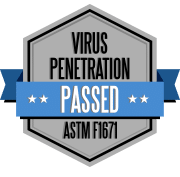We all know the importance of proper PPE usage, and the pandemic reinforced it with a grave lesson – patients and staff are at an intolerable risk when PPE shortages hit critical facilities. In the age of superbugs and with another pandemic only a “matter of time,” effective inventory management, especially for PPE supplies, is crucial.
Plus, efficient inventory management allows hospitals to control their costs by eliminating wastage and overstocking, and optimizes the flow of supplies, ensuring that the right items are available when needed. This reduces time wasted searching for supplies or waiting for restocks, keeping staff supplied and patients safe.
So, how do you keep everything in stock without wasting time and money? Let’s explore three inventory management strategies for healthcare & surgical facilities of every size:
3 Effective Inventory Management Strategies for Hospitals & Healthcare Facilities
Inventory management is a crucial aspect of the healthcare industry, ensuring that medical facilities have the necessary supplies and equipment to meet patient needs efficiently. Various inventory management strategies are employed in healthcare settings to optimize resource utilization, minimize waste, and improve patient care.
Let’s take a look at three different inventory management strategies commonly used in healthcare: Just-In-Time (JIT) inventory management, Workflow/Trigger-Based Vendor Managed Inventory (VMI), and an innovative Disposable & One-Size PPE stocking strategy that can cut down on a lot of headaches. Naturally, all these strategies aim to enhance supply chain efficiency, reduce costs, and maintain adequate stock levels of critical medical supplies.
Just-In-Time Inventory Systems
Just-In-Time (JIT) inventorying is a strategy used intended to maximize operational efficiency by reducing inventory levels and minimizing waste. Inventory is only ordered and received when it’s anticipated to be out of stock by the time the next order arrives; as the name implies, supplies arrive “just in time.”
This approach can help hospitals and healthcare facilities avoid excessive inventory holding costs and the risk of dealing with expired stock. By minimizing the inventory on hand, businesses can save on capital expenses, control inventory costs, and save storage space.
JIT has its risks. This strategy only functions when you have a close relationship with your suppliers, as it relies heavily on timely deliveries. You’ll need to find a supplier who prioritizes communication and quality control and has a dedicated delivery partner to ensure you get the supplies you need on time. Any failure in communication or coordination may lead to delays in delivery.
Even a minor disruption in the global supply chain or an unexpected increase in demand, as we saw during the COVID-19 pandemic, may cause shortages and stockouts. Implementing JIT requires precise planning and coordination across the entire supply chain. (Keep reading for ways to avoid this big risk!)
Vendor-Managed Inventory Workflows & Triggers
In a vendor-managed inventory (VMI) system, the vendor monitors your healthcare facility’s inventory levels and replenishes stock as needed, usually based on pre-determined agreements or through the use of technology that tracks inventory levels in real time. This can be a great way to control inventory costs and prevent excess inventory on hand.
VMI strategies can allow for more efficient inventory management, reduce stockouts or overstock situations, and lead to cost savings for both the vendor and your facility. It does require some technological setup on your end, and oftentimes, PPE must be scanned or “checked out,” from the supply room in order to trigger the software that manages supplies.
Surgeons and surgical staff, especially emergency department providers, often need to move quickly to serve a patient, and it’s common for supplies to be consumed without being scanned. After all, your medical staff is focused on providing care to patients, not on optimizing inventory.
When this happens often enough, your software-based count of supplies can be incorrect. This could lead to shortages and stockouts in your facility, so regular supply audits are necessary to keep track of inventory.
Best practices for an efficient Vendor Inventory Management system include:
1. Real-Time Tracking: Ensuring inventory levels are updated in real-time helps prevent stockouts and overstocking.
2. Accurate Forecasting: Analyzing historical sales data and market trends to forecast demand accurately enables better inventory planning.
3. Cycle Counting: Regularly conducting physical inventory counts to verify accuracy and identify discrepancies is crucial for maintaining inventory integrity.
4. Centralized Data: Having a centralized database that integrates with other business systems, such as sales and purchasing, helps streamline operations and improves visibility.
5. System Integration: Integrating the inventory management system with other software tools, such as accounting or supply chain management, facilitates seamless data flow and reduces manual data entry errors.
Replacing Key Supplies With One-Size and Disposable Solutions
One of the quickest ways you can simplify your PPE ordering process is by choosing PPE with one-size-fits-all technology. This approach ensures that one size can fit a majority of your healthcare staff, reducing the number of SKUs you need to track, and the number of boxes you need to store and stock. Not only does this save space, but it also simplifies the ordering process, as we only need to manage a single size.
In addition to switching to one-size-fits-all PPE when possible, disposable patient transfer sheets allow you to replace the ordering, storage, and sanitization of bulky patient transfer boards and their accompanying cleaning supplies. By switching to disposable patient transfer sheets, your facility can eliminate the need for these old-school boards. Disposable patient transfer sheets are stored in a dispenser on the wall of patient rooms, eliminating the need for extra space in your supply closet.
These disposable sheets offer a hygienic and convenient alternative, eliminating the time and effort required for cleaning and storage. Disposable sheets can also help reduce the risk of cross-contamination, ensuring a safer environment for patients and staff.
Defending Your Facility Against Supply Chain Issues
In today’s globalized world, supply chain disruptions have become a critical concern for businesses across industries. This is particularly true in the healthcare sector, where the need for PPE products is constant. Not only are healthcare facilities under immense pressure to procure adequate supplies of PPE, but they also need to ensure the continuous availability of these vital items to safeguard healthcare professionals and patients.
To mitigate the risk of supply chain disruptions, purchase your PPE products from North American manufacturers. By choosing a more local supplier, healthcare facilities can significantly reduce the potential for disruptions that may arise due to global logistical challenges or unforeseen events. This is particularly important if the facility operates on a Just-in-Time (JIT) inventory management system, where inventory levels are maintained at the bare minimum to minimize costs.
With a North American manufacturer, healthcare facilities benefit from shorter lead times, reduced shipping costs, and increased flexibility to adapt to changing demands or emergencies. Moreover, sourcing from within your region promotes a closer relationship between the facility and the manufacturer, fostering better communication and a clearer understanding of specific requirements.
By selecting a North American manufacturer, like Sloan Medical, for PPE products, healthcare facilities can proactively defend themselves against potential supply chain issues. This ensures a reliable and timely supply of essential PPE, allowing healthcare professionals to deliver the highest level of care while maintaining the safety of both themselves and their patients.
Throughout the pandemic, Sloan Manufacturing kept all our customers stocked with the PPE they rely on us to provide without disruption. By designing, manufacturing, and shipping our products within North America, we were able to keep the surgical staff that relies on us safe. In turn, these doctors and nurses were able to focus on providing quality patient care.
Inventory Management Will Save Your Healthcare Organization Time and Money
By effectively managing inventory, healthcare providers can prevent stockouts and overstocking, leading to reduced waste and cost savings. A well-organized inventory management system not only ensures that essential medical supplies, PPE, and medical equipment are readily available when needed but also minimizes the risk of expired or obsolete items.
Proper inventory management also enables healthcare facilities to avoid supply chain disruption, optimize storage space, and improve overall staff safety and patient care.
Is one-size-fits-all the right strategy for your disposable medical apparel? Should you switch from patient transfer boards to disposable patient transfer sheets?Order your free samples from Sloan and try these innovative solutions in your clinical environment, risk-free.





